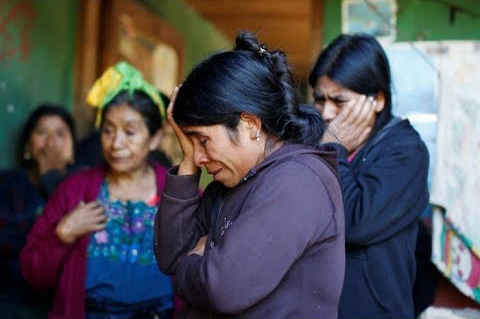Felipe Gómez Alonzo and his father left their modest mountain home with dreams of a new life. Now a community is grieving
by Sofia Menchú in Yalambojoch and José Alejandro García
From outside the flimsy two-bedroom shack, the sound of weeping could be heard as Catarina Alonzo mourned her eight-year old son.
Early in December, Felipe Gómez Alonzo and his father, Agustín Gómez Peréz, left the family’s modest home in the mountains of Guatemala with dreams of starting a new life in the US.
But the pair were detained near the US border just a few miles away from the Paso Del Norte port of entry in El Paso, and within six days, Felipe died in a New Mexico hospital – the second Guatemalan child to die this month while in US custody.
“I’m sad and in despair over the death of my son,” said Alonzo, when she emerged to speak to reporters.
US authorities are investigating the deaths of Felipe and seven-year-old Jakelin Caal, but the circumstances which drove both families to risk sending their children on the long journey north are clear: the absolute poverty besetting swathes of rural Guatemala.
Both children came from remote indigenous communities, where migration has long been seen a reasonable response to the country’s hardship, racism and violence.
“Felipe was happy to leave with his father,” said Alonzo in Chuj, an indigenous Mayan language.
She said that both parents had agreed to let Felipe join his father, an agricultural worker, on his trip north. Gómez Pérez hoped to find work to pay off his debts and send money to the family. Felipe hoped to study, and have a bicycle of his own.
When his father had second thoughts about taking him along, Felipe grew upset, so the two parents agreed he could go. Gómez Pérez even bought him a new pair of shoes for the trip, said Alonzo, through tears, her breath making clouds in the chill mountain air.
Throughout the journey, the family stayed in touch by mobile phone. “We talked as soon as they reached the border,” she said, adding that Gómez Pérez called again the next day when the pair were already in border patrol custody. “He said Felipe was okay and excited and healthy.”
This week, the US homeland security secretary, Kirstjen Nielsen, announced that migrant children would receive “more thorough” medical assessments when they are taken into custody – but she also blamed parents for putting their children at risk by embarking on the arduous journey.
But for many in rural Guatemala migration is seen as the only hope for a better life.
The 400km (250 mile) journey from the country’s capital to Felipe’s hometown takes roughly nine hours, starting out along the Pan-American highway.
Closer to Yalambojoch, however, the route becomes a treacherous dirt track winding through the mountains.
The village’s population is a little over a thousand; most of the adults spent years as refugees during Guatemala’s 1960-1996 civil war, in which the US-backed military committed a genocide on the country’s indigenous population.
In 1982, the Guatemalan army massacred more than three hundred people in Nentón. The survivors found refuge in Mexico, just nine kilometers away, and only returned years after, as the conflict came to an end.
But the peace deal did nothing to end Guatemala’s systemic racism and corruption, which has channelled the country’s wealth to a small urban elite, and the people of the surrounding Nentón municipality were forced to rebuild their communities without any governmental support.
In impoverished villages such as Yalambojoch, agriculture is the only work available.
Such grinding poverty makes emigration an attractive alternative, according to the town’s mayor, Lucas Pérez. “People leave our village, find work in the US and send money to help their relatives,” said Pérez, who estimated about 200 people from the tiny village live in the United States.
The surrounding Huehuetenango province sends the largest number of migrants from the country, according to Guatemala’s foreign ministry, and evidence of the exodus is clear:
Yalambojoch has no potable water or electricity, but among the wooden shacks are modern two-story houses with tiled roofs – built with remittance money from abroad.
According to the Banco de Guatemala, during this year’s first 11 months, Guatemalans living abroad sent their relatives close to $9m.
That was the dream of Gómez Pérez: to reach the US and provide for his family.
Before leaving Yalambojoch, Felipe shared a bedroom with both his parents and three siblings. The family home has a tin roof and earthen floors. Outside there are pigs, a few chickens, two roosters, a decrepit tomato plant and a mandarin tree.
Felipe’s father made about $6 a day, said Alonzo, who like most local people, subsists on coffee and corn tortillas.
In desperation Gómez Pérez took out a loan of several thousand dollars, and headed north.
Now, despite her son’s death, Alonzo still hopes he can remain in the US. “We have no other way to get rid of my husband’s debt,” she said.
Gómez Pérez remains in border patrol detention; medical examiners are still carrying out tests on his son’s body.
Guatemala’s president, Jimmy Morales, has made no public comment on the deaths of Felipe or Jakelin.
After speaking to reporters, Alonzo and her sisters went back to her bedroom, to a small altar she had assembled with fresh flowers, candles and pictures of Felipe a local teacher printed for her.
The women kneeled to pray the rosary in Chuj. (The Guardian).



